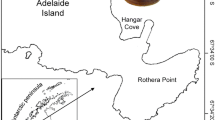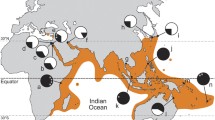Abstract
The northern Pacific asteroid Asterias amurensis (Lütken) has been recently introduced to Tasmania and is now well-established in east and southeast Tasmania. This sea star is conspicuous throughout the Derwent River estuary and is particularly abundant in the Hobart port area. Reproduction of two populations of A. amurensis at Sullivans Cove and at Sandy Bay was investigated from August 1993 to October 1994 by gonadal histology and measurement of the gonad index (GI). An intense period of vitellogenic and spermatogenic growth started in April, with the breeding condition reached by June. In 1994, peak GI was recorded at Sullivans Cove in July and at Sandy Bay in August. Although these data indicated that the Sullivans Cove population spawned before the Sandy Bay population, histological examination revealed that major spawning activity occurred in both populations from July onwards. In the early part of the breeding season, gametogenesis proceeded in parallel with spawning, with released gametes being replaced by continual gametogenesis. Maintenance of a higher GI during the early part of the breeding season at Sandy Bay was due to prolonged gametogenic replacement at this site. Spawning continued to October 1994, resulting in a sharp decline in the GI. The cyclic expansion and regression of the genital haemal sinus coincident with germinal proliferation and growth, respectively, support the contention that haemal fluid provides nutrients for gametogenesis. In Tasmania, A. amurensis experiences temperature and photoperiod regimes similar to those experienced by endemic populations of this species in the north Pacific. Comparison of reproduction of A. amurensis in Japan and Tasmania at similar latitudes shows that gametogenesis of the northern and southern populations is 6 mo out of phase. This phase shift provides evidence for photoperiodic regulation of gametogenesis in A. amurensis. The similar trend in sea-temperature regimes associated with the stages of gametogenesis in northern and southern populations suggests that temperature also plays a modulatory role. Based on the periodicity of reproduction and the ontogeny of A. amurensis, the planktotrophic larvae of this species would be expected to be in the plankton for several months from the end of winter through summer. Considering the highly fecund, dispersive life-history of A. amurensis, the southeast Tasmanian populations have considerable potential to serve as a seed source for establishment of new populations of this asteroid elsewhere in Tasmania and in mainland Australia.
Similar content being viewed by others
Author information
Authors and Affiliations
Additional information
Received: 18 October 1996 / Accepted: 22 October 1996
Rights and permissions
About this article
Cite this article
Byrne, M., Morrice, M. & Wolf, B. Introduction of the northern Pacific asteroid Asterias amurensis to Tasmania: reproduction and current distribution. Marine Biology 127, 673–685 (1997). https://doi.org/10.1007/s002270050058
Issue Date:
DOI: https://doi.org/10.1007/s002270050058




